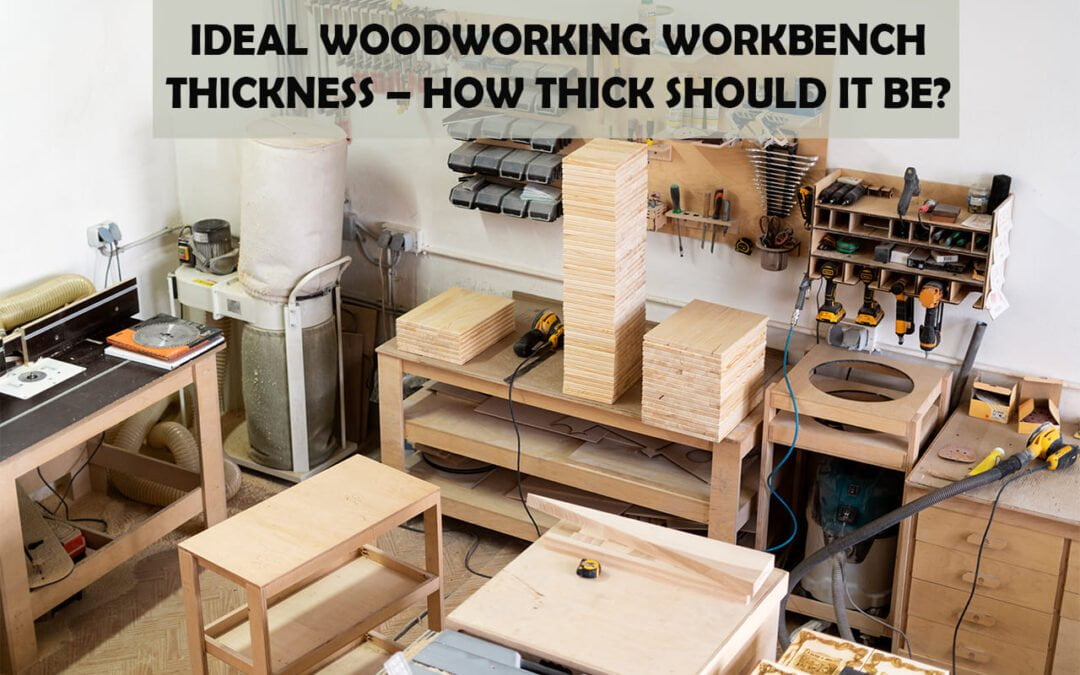Are you looking for a woodworking workbench that will give you the best results? One of the most important factors when choosing a bench is thickness. It’s essential to choose a thickness that suits your needs and provides stability and strength.
In this article, we’ll explore why thicker workbenches are beneficial when thinner ones might be more suitable, and what factors to consider when selecting one. We’ll also provide some tips to help you make sure your choice is the right one for your project.
So if you’re wondering how thick should a woodworking workbench be, read on!
Key Takeaways
- Thicker workbenches offer stability and strength for heavier projects
- Thicker boards are less likely to warp or shake during use
- Thicker boards can withstand heavier tools and materials
- Factors to consider when choosing workbench thickness: weight capacity, durability, and cost
Overview of Woodworking Workbenches
Crafting a workbench for your woodworking projects can be incredibly satisfying – and the thicker it is, the more you’ll enjoy it! A woodworking workbench is an essential piece of furniture that allows you to effectively use woodworking tools safely. It also serves as a surface to store and organize all the necessary safety precautions.
Thicker workbenches offer stability and strength for heavier projects, but there are other benefits to consider as well. Together, these benefits make a thicker workbench worth considering for any serious woodworker. Therefore, it’s important to understand why Breadth matters when creating a workbench.
Benefits of Thicker Workbenches
Building your workbench can be incredibly rewarding, and using a Heavier board means you’ll have more stability and durability. Breadth efficiency will be greater as Heavier boards are less likely to warp or shake during use.
Strength comparison is also heavily in favor of Heavier boards, which can withstand heavier tools and materials than thinner boards. All these factors add up to make thick boards the most efficient choice for your workbench.
However, some considerations with thinner boards need to be taken into account before starting construction.
Considerations for Thinner Workbenches
When choosing a workbench, you’ll need to consider the advantages of thinner boards for your project. Building materials like plywood and hardwood come in varying thicknesses, so selecting the right one is key.
Thinner wood types can work well for smaller projects that require less stability and strength. However, there are factors to take into account when choosing a workbench Breadth : weight capacity, durability, and cost.
Consider these factors before deciding on the best option for your project.
Factors to Consider When Choosing a Workbench Thickness
You need to be mindful of the specific factors when choosing the right workbench Breadth for your project – it can make all the difference in the success of your work.
Building material, wood species, and overall size are important considerations. The weight capacity required is another factor to consider, as well as any potential future modifications you may require. Be sure to research the different types of woods available and how they’ll affect both strength and stability.
Finally, don’t forget about cost; Denser materials tend to be more expensive, so budget should also play a role in selection. Taking these factors into account will ensure you find an appropriate Breadth that meets all your needs, allowing you to move on to tips for choosing a workbench thickness.
Tips for Choosing a Workbench Thickness
Choosing the right workbench Breadth for your project can be overwhelming, so it’s important to weigh all of your options carefully. Optimal sizing will depend on the type and size of the project you’re undertaking. Consider durability as a tradeoff – Denser materials may provide more stability but could add unnecessary weight.
For heavier benchtop projects, opt for Heavier boards or two layers of thinner boards for extra support. For lighter duties, thinner materials may suffice. Ultimately, choose the best option based on your needs and budget.
Conclusion
When it comes to choosing the right thickness for your woodworking workbench, you need to consider factors like what type of projects you’ll be completing and how much weight the bench needs to hold. It’s best to go with a thicker workbench if you plan on doing heavier projects or using larger tools, as this will give you more stability.
But if portability is important, then a thinner workbench may be better suited for your needs. In the end, it’s all about finding the perfect balance between practicality and durability when selecting the ideal thickness for your woodworking bench.

